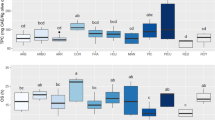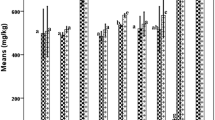Abstract
In this study, 278 samples of virgin olive oil from 40 mills belonging to five olive-growing zones of Extremadura were evaluated according to their fatty acid composition. An analysis of variance of the fatty acid contents, and their principal group subtotals and ratios revealed significant differences at the 95 % confidence level between zones. Means were compared using Tukey’s HSD test (p < 0.05). A discriminant analysis, taking the zone as the grouping variable and the different fatty acids and their ratios as independent variables, explained nearly 90 % of the variance with the first two functions. The model correctly classified 88.8 % of the analysed samples into their proper olive-growing zone. Validation against an extra test set of 30 samples resulted in 90 % being correctly classified; the results of the discriminant analysis were therefore considered to be validated. A two-dimensional graphical representation of the different groups studied using the first two resulting canonical discriminant functions clearly showed the Sierra Norte of Cáceres and Vegas del Guadiana each to be clearly separated from the rest and from each other, while the other three zones—Siberia, Serena and Tierra de Barros—overlapped considerably.


Similar content being viewed by others
References
MAGRAMA (2011) Anuario de estadística agroalimentaria. Ministerio de Agricultura, Alimentación y Medio Ambiente, Madrid
European Union Commission Regulation 2138/97 (1997) Delimiting the homogeneous olive oil production zones. Off J L 297:3–44
Gómez MC, Delgado FJ, Parra MC (2012) Identificación de variedades de olivo cultivadas en Extremadura mediante marcadores morfológicos y moleculares. Universidad de Extremadura, Cáceres
European Union Commission Regulation 182/2009 (2009) Amending Regulation (EC) 1019/2002 on marketing standards for olive oil. Off J L 63:6–8
Beers MH (2004) The Merck manual of medical information, 2nd edn. Merck, Rahway
Bucci R, Magri AD, Magri AL, Marini D, Marini F (2002) Chemical authentication of extra virgin olive oil varieties by supervised chemometric procedures. J Agric Food Chem 50:413–418
Aranda F, Gómez-Alonso S, Rivera del Álamo RM, Salvador MD, Fregapane G (2004) Triglyceride, total and 2-position fatty acid composition of Cornicabra virgen olive oil: comparison with other Spanish cultivars. Food Chem 86:485–492
Galeano T, Durán I, Sánchez J, Alexandre MF (2005) Characterisation of virgen olive oil according to its triglycerides and sterols composition by chemometric methods. Food Control 16:339–347
Ollivier D, Artand J, Pinatel C, Durbec J, Guérère M (2006) Differentiation of French virgin olive oil RDOs by sensory characteristics, fatty acid and triacylglycerol compositions and chemometrics. Food Chem 97:382–393
Vlahov G, Del Re P, Simone N (2003) Determination of geographical origin of olive oils using 13C nuclear magnetic resonance spectroscopy. I- Classification of olive oils of the Puglia region with denomination of protected origin. J Agric Food Chem 51:5612–5615
Lerma M, Herrero J, Rqamis G, Sinío E (2008) Prediction of the genetic variety of Spanish extra virgin olive Oliz using fatty acid and phenolic compound profiles established by direct infusion mass spectrometry. Food Chem 108:1142–1148
Zunin P, Boggie R, Lanteri S, Leardi R, De Andreis R, Evangelista F (2004) Direct thermal extraction and gas chromatographic-mass spectrometric determination of volatile compounds of extra-virgin olive oils. J Chromatogr A 1023:271–276
Boskou D (1996) Olive oil. Chemistry and technology. AOCS, Champaign
Diraman H (2010) Characterization by chemometry of the most important domestic and foreign olive cultivar from the National Olive Collection Orchard of Turkey. Grasas Aceites 61(4):341–351
Zarrouk W, Haddada F, Baccouri B, Oueslati I, Taamalli W, Fernandez X, Lizzario-Cuvelier L, Zarrouk M (2008) Characterization of virgin olive oil from Southern Tunisia. Eur J Lipid Sci Technol 110:81–88
Longobardi F, Ventrella A, Gasiello G, Sacco D, Tasioula-Margari ML, Kiritsakis AK (2012) Characterisation of the geographical origin of Western Greek virgin olive oils based on instrumental and multivariate statistical analysis. Food Chem 133:169–175
De Leonardis A, De Felice M, Macciola V (1996) Studio sulla composizione acidica degli oli vergini di oliva del Basso Molise. Riv Ital Sostanze Gr 73:321–325
Boggia R, Evangelisti F, Rossi N, Salvadeo P, Zunin P (2005) Chemical composition of olive oils of the cultivar Colombia. Grasas Aceites 56(4):276–283
Longobardi F, Ventrella A, Gasiello G, Sacco D, Catucci L, Agostiano A, Kontominas MG (2012) Instrumental and multivariate statistical analyses for the characterisation of the geographical origin of Apulian virgin olive oils. Food Chem 133:579–584
Pannelli G, Servili M, Selvaggini R, Baldioli M, Montedoro GF (1994) Effect of agronomic and seasonal factors on olive (Olea Europaea L.) production and on the qualitative characteristics of the oil. Acta Horticulturae 356:239–243
Poiana M, Minciane A (2004) Fatty acids evolution and composition of olive oils extracted from different olive cultivars grown in Calabrian area. Grasas Aceites 55:282–290
Gracia M, Royo A, Guillén M (2009) Composición química de aceites de las variedades Arbequinas y Empeltre cultivadas en regadio. Grasas Aceites 60(4):321–329
Motilva MJ, Ramo T, Romero MP (2001) Caracterización geográfica de los aceites de oliva vírgenes de la denominación de origen protegida “Les Garrigues” por su perfil en ácidos grasos. Grasas Aceites 52(1):26–32
Pardo JE, Cuesta MA, Alvarruiz A, Granell JD, Álvarez-Ortíz M (2011) Evaluation of potential and real qualities of virgin olive oil from the designation of origin (DO) “Aceite Montes de Alcaraz” (Albacete, Spain). Food Chem 124:1684–1690
Pardo JE, Cuesta MA, Alvarruiz A (2007) Evaluation of potential and real quality of virgin olive oil from the designation of origin (D.O.) “Aceite Campo de Montiel” (Ciudad Real, Spain). Food Chem 100:977–984
Pardo JE, Sena E, Cuesta MA, Granell JD, Valiente J, Álvarez-Ortí M (2013) Evaluation of potential and real quality of virgin olive oil from “Campos de Hellín” (Albacete, Spain). J Am Oil Chem Soc 90:851–862
Salvador MD, Aranda F, Fregapane G (2001) Influence of fruit ripening on “Cornicabra” virgin olive oil quality. A study of four successive crop seasons. Food Chem 73:45–53
Sánchez JJ, Osorio E, Montaño A, Martínez M (2003) Estudio del contenido en ácidos grasos de aceites monovarietales elaborados a partir de aceitunas producidas en la región extremeña. Grasas Aceites 54(4):371–377
Sánchez JJ, De Miguel C, Osorio E, Marín J, Fuentes M, Ardila T, Gallardo L, Martínez M (2009) Characteristics of virgin olive oil from de olive zone of extremadura (Spain), approximation to their varietal origin. J Am Oil Chem Soc 86:933–940
Baccouri O, Guerfel M, Baccouri B, Cerretani L, Bendini A, Lercker G, Zarrouk M, Daoud D (2008) Chemical composition and oxidative stability of Tunisian monovarietal virgin olive oils with regard to fruit ripening. Food Chem 109(31):743–754
Lazzez A, Vichi S, Kammoun NG, Arous MN, Khlif M, Romero A, Cossentini M (2011) A four year study to determine the optimal harvesting period for Tunisian Chemlali olives. Eur J Lipid Sci Tech 113:796–807
Oueslati I, Anniva C, Daoud D, Tsimidou MZ, Zarrouk M (2009) Virgin olive oil (VOO) production in Tunisia: the commercial potential of the major olive varieties from the arid Tataouine zone. Food Chem 112:733–741
Zarrouk W, Baccouri B, Taamalli W, Trigui A, Daoud D, Zarrouk M (2009) Oil fatty acid composition of eighteen Mediterranean olive varieties cultivated under the arid conditions of Boughrara (Southern Tunisia). Grasas Aceites 60(5):498–506
Vekiari SA, Oreopoulou V, Kourkoutas Y, Kamoun N, Msallem M, Psimouli V, Arapoglou D (2010) Characterization and seasonal variation of the quality of virgin olive oil of the Throumbolia and Koroneiki varieties from Southern Greece. Grasas Aceites 61(3):221–231
Dıraman H, Saygi H, Hisil Y (2011) Geographical classification of Turkish virgin olive oils from the Aegean Region for two harvest years based on their fatty acid profiles. J Am Oil Chem Soc 88(12):1905–1915
European Union Commission Regulation (EEC) 2568/91 (1991) On the characteristics of olive and olive pomace oils and their analytical methods. Annex II: determination of acidity value. Annex III: determination of peroxide index. Annex IX: spectrophotometric test of uv absorption. regulation EEC/1429/92 on the Modifications to the Regulation EEC/2568/91. Off J L248:6–36
International Olive Oil Council (2003) trade standards applying to olive oil and olive-pomace oil. COI/T15/NC No 3.
Tous J, Romero A, Díaz I (2005) Composición del aceite. In: Rallo L, Barranco D, Caballero JM, Del Rio C, Martín A, Tous J, Trujillo I (eds) Variedades de olivo en España. Junta de Andalucia, Ministerio de Agricultura Pesca y Alimentación, Madrid, pp 359–382
Rondanini DP, Castro DN, Searles PS, Rousseaux MC (2011) Fatty acid profiles of varietal virgin olive oils (Olea europaea L.) from mature orchards in warm arid valleys of Northwestern Argentina (La Rioja). Grasas Aceites 62(4):399–409
Sadeghi H, Talaii AR (2002) Impact of environmental conditions on fatty acids combination of olive oil in an Iranian olive, cv Zard. Acta Horticulturae 586:579–582
Morales MT, Aparício R (1999) Effect of the extraction conditions on virgin olive oil sensory quality. J Am Oil Chem Soc 76:295–300
Kiritsakis AK (1998) Olive oil: from the tree to the table. Food & Nutrition, Trumbull
Velasco J, Dobarganes C (2002) Oxidative stability of virgin olive oil. Eur J Lipid Sci Technol 104:661–676
D’Imperio M, Dugo G, Alfa M, Mannina L, Segre A (2007) Statistical analysis on Sicilian olive oils. Food Chem 102:956–965
Acknowledgments
This work is the result of different Regional Research Projects funded by the European Union and the Government of Extremadura. M.N. Franco wishes to thank the European Social Fund and the Government of Extremadura for the scholarship awarded (TEC09072). The authors also wish to thank J. Hernández Carretero, J.M. García Ballesteros and J. Nogales Barahona for their invaluable cooperation.
Author information
Authors and Affiliations
Corresponding author
About this article
Cite this article
Martínez, M., Fuentes, M., Franco, N. et al. Fatty Acid Profiles of Virgin Olive Oils from the Five Olive-Growing Zones of Extremadura (Spain). J Am Oil Chem Soc 91, 1921–1929 (2014). https://doi.org/10.1007/s11746-014-2528-9
Received:
Revised:
Accepted:
Published:
Issue Date:
DOI: https://doi.org/10.1007/s11746-014-2528-9




